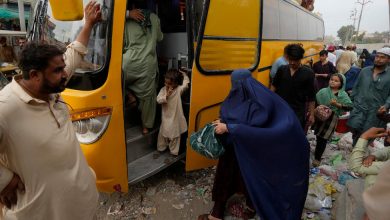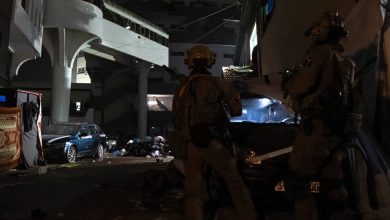Ukraine Plans Evacuations in 2 Stricken Cities as Temperatures Plunge

The Ukrainian government is preparing to help evacuate residents from two cities where shattered electricity and heating infrastructure has raised fears of a humanitarian crisis when winter sets in, officials said over the weekend.
But even as planning for the evacuations from the southern cities of Kherson and Mykolaiv was beginning, still more immediate concerns arose on Sunday when at least a dozen shells exploded at a major nuclear plant in the same region. International atomic energy authorities likened the shelling to “playing with fire.”
As Ukraine braced for a difficult winter ahead, both in cities on the front line and across the country, the true toll of the last eight months of fighting became still clearer.
The country’s prosecutor general reported on Sunday that some 437 children were now believed to be among the more than 8,300 civilians killed since the Russian invasion of Ukraine began in February. With reliable information from Russian-occupied areas scarce, the true death toll is likely to be far higher, said Andriy Kostin, the prosecutor general. More than 11,000 civilians have been injured, he said.
With Russia’s unrelenting bombardment of critical infrastructure, officials across the country are worried about how to help Ukrainians fare in a winter when obtaining even the most basic necessities may be a struggle. But in Kherson, where Ukrainian soldiers found a crippled city when they pushed the Russian occupiers out just over a week ago, the authorities say that for many residents, the only solution may be to leave.
With supplies of running water, heat and electricity precarious in the newly liberated city, Ukraine’s deputy prime minister, Iryna Vereshchuk, said that in the next few days the government would begin helping people who wish to leave. But she emphasized that residents will make their own decisions on whether to stay.
“Currently, we are not talking about forced evacuation,” she said. “But even in the case of voluntary evacuation, the state bears responsibility for transportation. People must be taken to the place where they will spend the winter.”
In the days since Russian forces retreated from Kherson and Ukrainian forces swept into the city, the government has scrambled to assess the humanitarian situation and rebuild vital infrastructure, working tirelessly to restore basic services. As temperatures begin to plunge, the first traces of power have reappeared in the city in recent days.
Speaking on Saturday in the port city of Mykolaiv, about 40 miles to the northwest of Kherson, Ms. Vereshchuk said the government would also help residents there evacuate. Mykolaiv is a frequent target of Russian missile strikes, and residents of both cities have asked to be moved to safer areas, she said.
The State of the War
- Explosion in Poland: A Ukrainian air-defense missile — not a Russian weapon — most likely caused a deadly explosion in a Polish village, a top NATO official and Poland’s president said, easing fears that the military alliance would become more deeply embroiled in the war.
- Retaking Kherson: On Nov. 11, Ukrainian soldiers swept into the southern city of Kherson, seizing a major prize from the retreating Russian army and dealing a bitter blow to President Vladimir V. Putin. Days after the liberation, evidence and accounts of torture are emerging.
- Infrastructure Attacks: In a relentless and intensifying barrage of missiles, Moscow is destroying Ukraine’s critical infrastructure, depriving millions of heat, light and clean water. For Ukraine, keeping the lights on as winter looms has become one of its biggest battles.
- Beta Testing New Weapons: Ukraine has become a testing ground for state-of-the-art weapons and information systems that Western officials predict could shape warfare for generations to come.
Many of those who remain are older or infirm.
Even before Ukrainian forces reclaimed the city, thousands of civilians left occupied Kherson. Then, as the city was slipping through Russia’s fingers and Russian forces prepared to retreat, the occupation government said residents should leave for territory still under Moscow’s control east of the Dnipro River or into Russia itself.
Russian forces on the east bank of the river have continued to shell the city, and the area is riddled with land mines. Local officials have warned that there is still a high probability of Russian attacks, including the targeting of civilians, and as if to emphasize the point, on Saturday night a rocket sailed into an oil storage facility in Kherson, igniting a spectacular fire that belched black smoke over the city.
Yaroslav Yanushevych, the head of the Kherson regional military administration, said on Sunday that some 80 tons of humanitarian aid had been delivered to the city by aid organizations. It includes thousands of hygiene kits and blankets, generators, drinking water, and winter clothing for children. Mr. Yanushevych posted a video on his social media channels showing eight ambulances that had been delivered to the city by the Ministry of Health.
In the Zaporizhzhia region, some 175 miles northeast of Kherson on the Dnipro River, there were reports on Sunday of at least a dozen shells exploding at the Zaporizhzhia power plant. The strikes on the facility, the largest nuclear plant in Europe, damaged equipment. The United Nations’ nuclear watchdog agency called the shelling “extremely disturbing.”
Russian and Ukrainian nuclear energy authorities each blamed the other side’s forces for the strikes, the latest to hit a plant where a number of incidents in recent months have raised fears of a nuclear disaster. The plant is currently occupied by Russian forces.
“Whoever is behind this, it must stop immediately,” Rafael Mariano Grossi, director general of the U.N. International Atomic Energy Agency, said in a statement. “As I have said many times before, you’re playing with fire!”
The shelling damaged water storage tanks, a steam purge generator system and other equipment, Energoatom, Ukraine’s state nuclear company, said in a post on the Telegram messaging app.
Russia’s nuclear agency, Rosenergoatom, blamed Ukraine’s military for the shelling. An adviser to the company’s director general, Renat Karchaa, told the state-owned Russian news agency Tass that 15 shells had landed, and that a building where nuclear fuel is stored had been hit.
“Any artillery strikes at a nuclear power plant jeopardize nuclear safety,” Mr. Karchaa said.
As a safety measure, all of the reactors have been cycled down. The full extent of the damage to the facilities was not immediately clear.
The shelling on Sunday came after weeks of what the U.N. nuclear agency described as relative calm at the plant. Mr. Grossi renewed his appeals for the plant to be made into a demilitarized zone. In recent weeks, he has held talks with both the Russian and Ukrainian leaders to promote the plan, but without apparent success.
Across the Zaporizhzhia region, there has been significant damage to power and gas infrastructure, and by Sunday, tens of thousands of people across dozens of communities were without electricity or heat, the regional military administration said in a statement.
Major concerns about the country’s power grid, though, extend far beyond the southern and eastern parts of the country where the fighting has been focused, with Russian forces having carried out widespread missile strikes on infrastructure across Ukraine since mid-October.
Oleksandr Kharchenko, director of the Energy Industry Research Center in Ukraine, said that a series of strikes last week had left the national power grid badly damaged, and that the authorities had “not yet had time to restore it to the level” at which the country would be able to avoid widespread blackouts if there were further attacks.
“It’s hard on morale when you work, recover it, and they hit it again and again,” he said at a news briefing on Sunday. “However, the recovery works continue.”
The situation is improving by the hour, Mr. Kharchenko said. But, he said, the country needs 10 to 12 days “to restore stability of the grid so that we could look more confidently at the next attacks.”
With no end of the fighting in sightand temperatures dropping, the government has urged Ukrainians outside the country not to return yet. More than 7.8 million people have fled Ukraine since February, according to the United Nations refugee agency, the largest displacement of people in Europe since World War II.
And on Saturday, the head of Ukraine’s biggest private energy firm, DTEK, said that others should consider leaving the country to reduce the demand on the power network.
“If they can find an alternative place to stay for another three or four months,” Maxim Timchenko, the DTEK chief executive, told the BBC, “it will be very helpful to the system.”
Finbarr O’Reilly, Ben Shpigel and Cassandra Vinograd contributed reporting.





